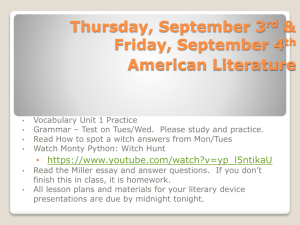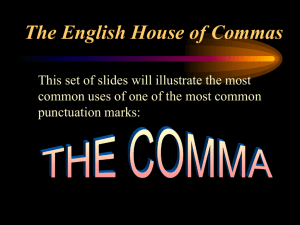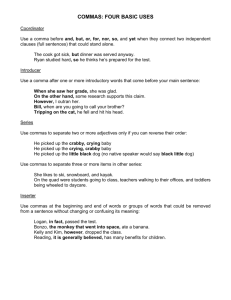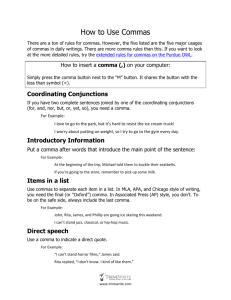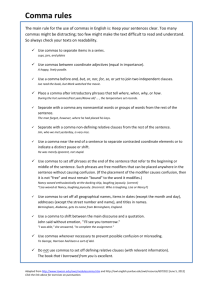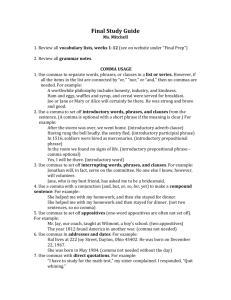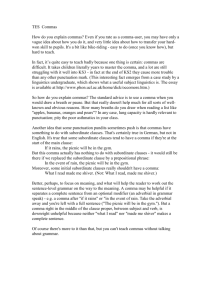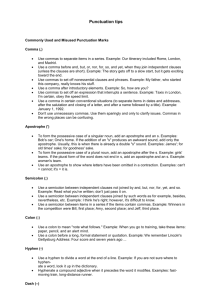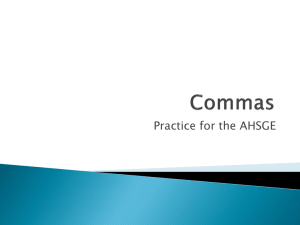Punctuation Rules
advertisement
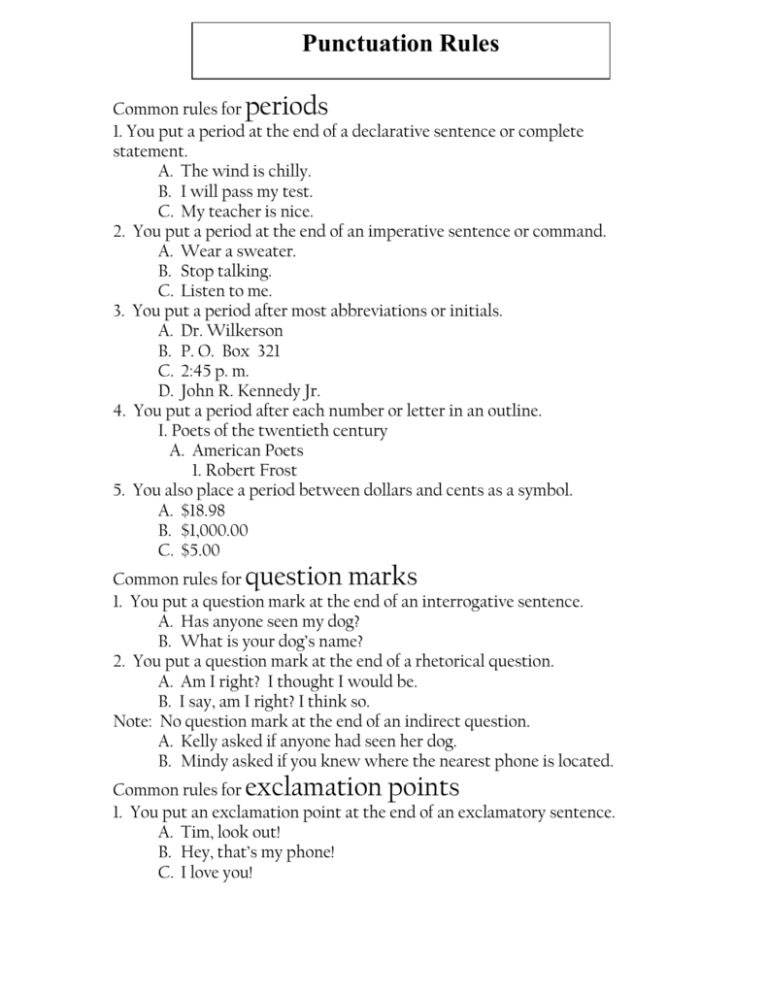
Punctuation Rules Common rules for periods 1. You put a period at the end of a declarative sentence or complete statement. A. The wind is chilly. B. I will pass my test. C. My teacher is nice. 2. You put a period at the end of an imperative sentence or command. A. Wear a sweater. B. Stop talking. C. Listen to me. 3. You put a period after most abbreviations or initials. A. Dr. Wilkerson B. P. O. Box 321 C. 2:45 p. m. D. John R. Kennedy Jr. 4. You put a period after each number or letter in an outline. I. Poets of the twentieth century A. American Poets 1. Robert Frost 5. You also place a period between dollars and cents as a symbol. A. $18.98 B. $1,000.00 C. $5.00 Common rules for question marks 1. You put a question mark at the end of an interrogative sentence. A. Has anyone seen my dog? B. What is your dog’s name? 2. You put a question mark at the end of a rhetorical question. A. Am I right? I thought I would be. B. I say, am I right? I think so. Note: No question mark at the end of an indirect question. A. Kelly asked if anyone had seen her dog. B. Mindy asked if you knew where the nearest phone is located. Common rules for exclamation points 1. You put an exclamation point at the end of an exclamatory sentence. A. Tim, look out! B. Hey, that’s my phone! C. I love you! 2. You put an exclamation point after an interjection or any other exclamatory expression. A. Hurry! B. Wow! What a catch! Common rules for Commas 1. You put a comma after every item in a series except the last thing. A. The flag is red, white, and blue. (The commas in this sentence separate named items.) B. The dog ran out the door, down the steps, and across the lawn. (The commas in this sentence separate phrases.) C. How kangaroos run, what jumps they take, and how they live are explained in this book. (The commas in this sentence separate clauses.) 2. You put a comma between two or more describing words in a row. A. They drove away in a bright, shiny, expensive sports car. B. The specials include crisp, fresh cut carrots as the side item. 3. You put a comma between words in a list or series. A. Please buy the following at the store: eggs, bacon, and bread. B. There are three ways to get good grades: first, pay attention; second, take notes; third, study. C. I have narrowed my college choices to three: University of Texas, U of H, and SHSU. 4. You put a comma after words that start off paragraphs, phrases or clauses. A. Yes, I will go. B. After circling twice, the airplane landed. C. Although Dick needed help, he said nothing. 5. You put a comma to set off words (or groups) that interrupt the thought flow. A. Anne, to tell the truth, was quite happy. 6. You use commas to set apart direct addresses. A. If you look, Steve, you will see what I mean. B. Mary, don’t do that. C. Be careful, Jim, when you try that stunt. 7. You use commas to set apart appositives. A. The speaker, a famous explorer, told about far away places. B. The leader, the person on horseback, moved away. C. Mrs. Castellano, my English teacher, read her journal. 8. You use commas to set off direct quotations. A. Kate shouted, “Keep your eye on the ball!” B. “I cannot find the key,” said Smitty. C. “The spacecraft,” the announcer said, “has just lifted off.” 9. You use a comma when you are connecting sentences ‘ (when your connecting word is three letters or less) A. Kim seemed to agree, and no one else objected. B. Pete got there late, but it was earlier than Lisa. 10. You put a comma when you are writing the date with the month first. A. My wedding date is going to be January 18, 2022. B. The postmark read September 10, 1981, but we didn’t receive it until yesterday. 11. You put a comma between locations and addresses. A. Miami, Florida B. Forward my mail to 651 Marshal Drive, Newark, New Jersey 07124. 12. You put a comma in a letter format. A. Dear Conroe Courier Editor, B. Sincerely yours, C. Thank you, D. Thanks, 13. You set off commas for the reader/to provide clarity. A. Who she is, is a mystery B. The boyfriend who I had had, had all his teeth pulled, and is now hers to have. Common rules for Semicolons 1. You put a semicolon to join clauses when no coordinating conjunction is used. A. Dan has finished his homework; Darcy has not begun hers. B. Do the laundry; wash the dishes; clean the floors; then, you can sleep. 2. You put a semicolon before connecting words with more than three letters in the word. A. It was a sunny day; however, I did not feel “sunny” inside. B. I love to shop; consequently, I don’t have a big savings. Common rules for Colons 1. You put a colon after a greeting in a really formal letter. A. Dear Sir or Madam: 2. You put a colon in between numerals indicating hours and minutes. A. 10:00 3. You put a colon when you are introducing a list of items. A. I am grounded from all of these things: my satellite, my phone, my computer, my CD player, and even from my friends.

